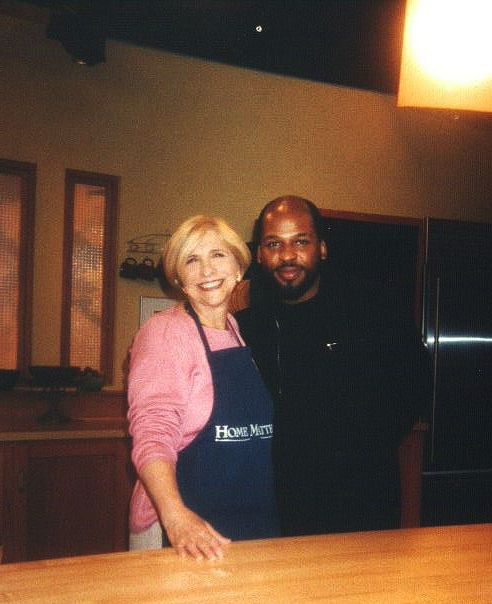
PRIMOS, Pennsylvania – Nathalie Dupree had several cooking series on PBS during the 1990s. In 1999, as a 33-year-old executive producer in Daytime Programming at Discovery, one of the programs under my purview was a craft show called Home Matters, which was produced by Banyan Productions, and hosted by 1981 Miss America, Susan Powell. Banyan had offices at 225 Arch Street in downtown Philadelphia, and I traveled there frequently for production meetings for both Home Matters and A Wedding Story, also produced by Banyan. When Nathalie Dupree was booked for Home Matters, I made sure to be in Philly during the taping; in fact, I rode in the production van to pick up Ms. Dupree at her hotel and drove with her to the studio in the neighboring city of Primos. She was quite the raconteur along the way. By that time, I had been watching Nathalie Dupree cook on television for several years, and I had purchased a few of her books.
Nathalie Dupree was one of the first television cooks to inspire me in the kitchen. In her 1993 book, Nathalie Dupree’s Southern Memories: Recipes and Reminiscences, Ms. Dupree writes: “My South ranges from the Eastern Shore of Maryland through the District of Columbia and Virginia, taking in the Carolinas, weaving its way around West Virginia, embracing Georgia, Tennessee, Arkansas, Alabama, and Mississippi…My South is the South where I ate fried fish for my wedding supper on the island of Ocracoke in the Outer Banks. It is memories of the massive black babysitter who tenderly cradled me between vast bosoms while she played the piano and crooned the blues and I ate an angel biscuit smeared with jam…It is the place where with pigs and some turnip greens you could last out hard times, where a kitchen garden made the difference between living and barely living…While I love all of the United States, the south is my soul.”
There is not much about Nathalie Dupree’s South that I romanticize about, as I do not consider myself southern, even though I was born in Washington, D.C., raised in Prince George’s County, lived most of my adult life in the DMV (District-Maryland-Virginia metropolitan area), and now reside on the Eastern Shore of Maryland. Geographically, I am included in “the South” of which Ms. Dupree writes, although I do not identify as a southerner. Both of my parents were born and raised in a small steel mill town outside of Pittsburgh, so they are northerners who married and moved to Washington, D.C., where they started a family, before leaving the city for life in the suburbs of Maryland.
What draws me to Nathalie Dupree’s South, and to her southern memories, is the food, some of which migrated with the Black people who fled the South after the Civil War; they took with them the cooking techniques, if not the specific ingredients. Pork is a food that traveled well, as ham has always been a part of my eating life in Maryland. Grits, on the other hand, did not make the journey to my family table. The tradition of maintaining a backyard (or side yard) kitchen garden was not practiced in my family. The waterways have given us, though, what we are most known for in Maryland: blue crabs.
My maternal great-grandfather, James Henry Hairston, was born a free Mulatto man on the Cooleemee Plantation in Davie County, North Carolina in 1869. At 28, he married and started a family, eventually migrating from Winston-Salem to North Braddock, Pennsylvania, some time between 1900-1908. His second daughter, my grandmother Clara Hairston, was born in Forsyth County, North Carolina, and was around the age of 10 when the family moved up north. Clara grew up to have my mother, also named Clara. This family foodway, from the rural south to the industrial north, shows up in what my grandmother served my mother in their North Braddock of the 30s, 40s, and 50s, and in what my mother eventually put on our Maryland family table in the 60s, 70s, and 80s. Because we had no relatives living in “the South,” we didn’t travel there for summer vacations when I was growing up; instead, we drove north, from Maryland to Pennsylvania, so that all I really knew about southern food was that version of it that showed up on the plate in Prince George’s County.
My Maryland memories do not include seeing pickers and planters in the fields by our home. Nearby the neighborhood, there were larger swaths of land with what looked like once plantation homes on them, but no one I ever knew could tell you who lived there. There were no children from those one or two households who ever went to any school I ever attended. Those homes, that land appeared to be a remnant of a bygone era, ghosts of yesteryear.
My mother and father never really talked about the food of their childhoods. I have heard of my mother learning from her mother how to make biscuits by hand. There are stories of my maternal grandmother making pies. While the food varied from the South to the North, the tradition of gathering around food is as old as human history, only differentiated by the cultural norms of each group. I have vivid memories of backyard cookouts and card games with the kinfolks, all fueled by healthy volumes of music, lots of alcohol, and the occasional waft of burning reefer.
The first time I made gravlax at home, it was from a Nathalie Dupree recipe, found in one of her cookbooks.